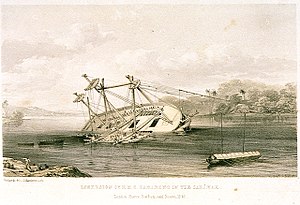
HMS Beagle was a Cherokee-class 10-gun brig-sloop of the Royal Navy, one of more than 100 ships of this class. The vessel, constructed at a cost of £7,803, was launched on 11 May 1820 from the Woolwich Dockyard on the River Thames. Later reports say the ship took part in celebrations of the coronation of King George IV of the United Kingdom, passing through the old London Bridge, and was the first rigged man-of-war afloat upriver of the bridge. There was no immediate need for Beagle so she "lay in ordinary", moored afloat but without masts or rigging. She was then adapted as a survey barque and took part in three survey expeditions.

Cathodic protection is a technique used to control the corrosion of a metal surface by making it the cathode of an electrochemical cell. A simple method of protection connects the metal to be protected to a more easily corroded "sacrificial metal" to act as the anode. The sacrificial metal then corrodes instead of the protected metal. For structures such as long pipelines, where passive galvanic cathodic protection is not adequate, an external DC electrical power source is used to provide sufficient current.

HMS Rattlesnake was an Atholl-class 28-gun sixth-rate corvette of the Royal Navy launched in 1822. She made a historic voyage of discovery to the Cape York and Torres Strait areas of northern Australia.

HMS Ajax was a 74-gun third rate ship of the line of the Royal Navy, launched on 2 May 1809 at Blackwall Yard.

HMS Sulphur was a 10-gun Hecla-class bomb vessel of the British Royal Navy, famous as one of the ships in which Edward Belcher explored the Pacific coast of the Americas.
Arthur Adams was an English physician and naturalist.

HMS Warspite was a 74-gun third-rate ship of the line of the Royal Navy, launched in 1807. She served in the Napoleonic Wars and was decommissioned in 1815. After conversion to a 76-gun ship in 1817 she circumnavigated the world, visiting Australia. She was cut down to a single decker 50-gun frigate in 1840 and was decommissioned in 1846. She was lent as a boys' training ship to The Marine Society and was lost to fire in 1876.

HMS Alarm was a 32-gun fifth-rate Niger-class frigate of the Royal Navy, and was the first Royal Navy ship to bear this name. Copper-sheathed in 1761, she was the first ship in the Royal Navy to have a fully copper-sheathed hull.

HMS Terrible was when designed the largest steam-powered wooden paddle wheel frigate built for the Royal Navy.

HMS Fisgard was a 46-gun fifth rate Leda-class frigate of the Royal Navy. She spent sixty years in service on a variety of duties.

HMS Thetis was a 36-gun fifth-rate frigate of the Royal Navy. After nearly a decade of service with the British, she was transferred to Prussia in exchange for two steam gunboats. She served with the Prussian Navy, the North German Federal Navy and the Imperial German Navy as a training ship until being stricken in 1871. Thetis was subsequently converted into a coal hulk and broken up in 1894–95.

HMS Endymion was a 21-gun Ister-class wooden screw frigate, the third of four ships of this name to serve in the Royal Navy. She was the last wooden frigate built at Deptford Dockyard. She was commissioned in 1866 and spent much of her service based at Malta. In 1869–70 she sailed around the world as part of a Flying Squadron. She remained in front-line service until 1874.

HMS Constance was a Comus-class steel corvette of the Royal Navy. She was launched from Chatham Dockyard on 9 June 1880.

HMS Jackal was a Jackal-class second-class iron paddle gunvessel of the Royal Navy.
Four ships of the Royal Navy have either borne the name HMS Samarang or were intended to bear the name, after the port of Samarang, the site of HMS Psyche's capture of several Dutch vessels there in 1807.
The Dutch corvette Scipio was launched in 1784. She convoyed Dutch East Indiamen between the Cape of Good Hope and Europe until HMS Psyche captured her at Samarang in 1807. The British Royal Navy initially referred to her as HMS Scipio, but then renamed her to HMS Samarang in 1808. (She was not commissioned in the Royal Navy. She was instrumental in the capture of Amboyna and especially Pulo Ay, and participated in the invasion of Java. She was sold at Bombay in 1814. She then entered mercantile service, sailing between Liverpool and India until 1827. She became an opium trader sailing between India and Canton, and was broken up near Hong Kong in August 1833.

Galvanic corrosion is an electrochemical process in which one metal corrodes preferentially when it is in electrical contact with another, in the presence of an electrolyte. A similar galvanic reaction is exploited in primary cells to generate a useful electrical voltage to power portable devices.
Richard Brinsley Hinds FRCS was a British naval surgeon, botanist and malacologist. He sailed on the 1835–42 voyage by HMS Sulphur to explore the Pacific Ocean, and edited the natural history reports of that expedition.

HMS Cyclops was a paddle wheel steam frigate built for the Royal Navy and launched in 1839 and taken out of service in 1861 and sold for breaking in January 1864. She saw action in the Syrian War in 1840 and the Crimean War in 1854, later being involved in laying the first Transatlantic telegraph cable in 1858.
















